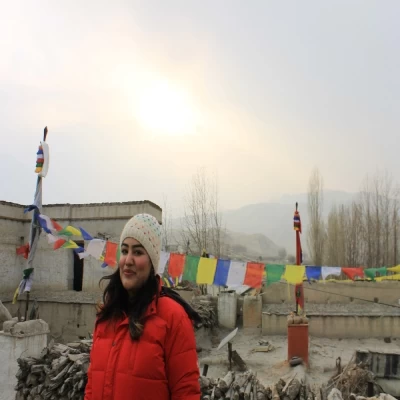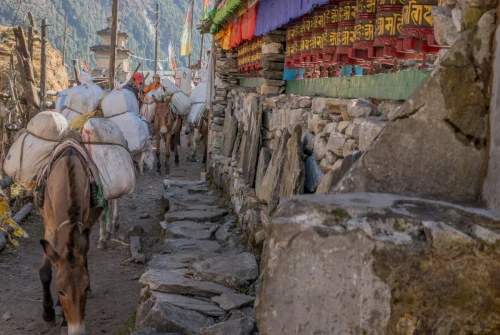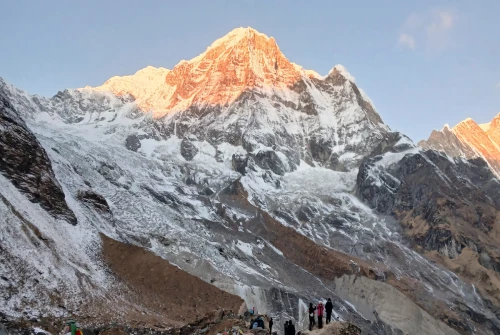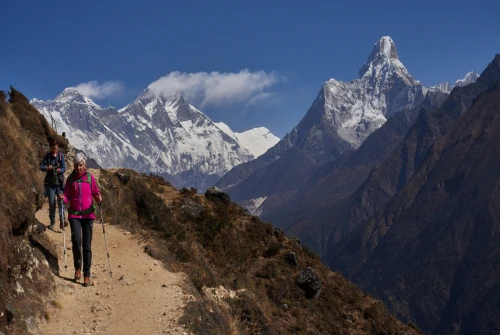So you’re considering taking on the Manaslu Circuit Trek, you're making an excellent choice! Among the various trekking options available in Nepal, such as the Annapurna Circuit, Everest Three Passes, Langtang Valley, and Upper Mustang, the Manaslu Circuit stands out as one of the finest. It offers a diverse and breathtaking range of scenery, and in a world where development is rapidly changing landscapes, the Manaslu Trek retains its charm as a less-traveled route, with fewer disruptions from road construction. Moreover, as you ascend to higher altitudes, you'll experience the captivating influence of Tibetan culture, which adds a unique and distinct flavor to the trek that sets it apart from other regions.
In this comprehensive guide, we will delve into various crucial aspects of the Manaslu Circuit Trek. We'll provide insights on the best times to embark on this adventure, the essential items to pack, tips for organizing your trek, budgeting considerations, information about accommodation options, details about the local cuisine, and much more. If you're eager to learn more about the specific itinerary for the Manaslu Circuit Trek, we've got you covered with that as well.
The Manaslu Circuit Trek is a less-traveled and off-the-beaten-path trekking route located in the Himalayas of Nepal. This particular trek takes you on a remarkable journey around the base of Mount Manaslu, which is the eighth-highest mountain in the world. As you embark on this adventure, you'll have the opportunity to spend each night in a different Tibetan village, immersing yourself in the local culture and traditions. The scenery along the Manaslu Circuit Trek is nothing short of awe-inspiring. Throughout the trek, you'll be treated to breathtaking views of snow-capped peaks, lush forests, terraced fields, and pristine alpine landscapes. However, the most spectacular part of the journey often comes during the final days of the circuit when you ascend to altitudes exceeding 5000 meters (approximately 16,400 feet) while making your way across the Larke Pass, also known as Larkya La Pass. Larke Pass is one of the highlights of the Manaslu Circuit Trek. It's a high mountain pass that presents a challenging but incredibly rewarding experience for trekkers. As you cross this pass, you'll be surrounded by towering peaks, glaciers, and panoramic vistas that stretch as far as the eye can see. The sense of accomplishment and the stunning natural beauty make reaching Larke Pass a memorable moment in the trek.
Overall, the Manaslu Circuit Trek offers a unique and less-crowded alternative to some of the more popular treks in Nepal. It provides trekkers with a chance to explore remote Tibetan villages, soak in the diverse landscapes, and ultimately, witness the grandeur of the Himalayas, especially during the crossing of Larke Pass.
Manaslu Circuit Trek Overview:
Trek Distance: Approximately 180 kilometers, spanning from Machhakola to Dharapani.
Duration: Typically completed in 12 days.
Total Ascent (including undulations): Approximately 11,000 meters.
Total Descent (including undulations): Approximately 9,800 meters.
Highest Elevation Reached: The peak point of the trek stands at 5,200 meters, located just above Larke Pass (Larkya La Pass), typically encountered on the 11th day of the journey.
Manaslu Circuit Trek Itinerary
Here is a suggested itinerary for the Manaslu Circuit Trek, but please note that it's flexible and can be adjusted. Some trekkers may choose different villages to stay in or include an extra acclimatization day at Samdo. The distances and trekking times mentioned are approximate and can vary based on individual preferences and conditions.
Day 1: Drive from Kathmandu to Soti Khola(730m)
Day 2: Trek from Soti Khola to Machha Khola(900m)
Day 3: Trek from Machha Khola to Doban(1070m)
Day 4: Trek from Doban to Philim(1570m)
Day 5: Trek from Philim to Deng(1860m)
Day 6: Trek from Deng to Ghap(2250m)
Day 7: Trek from Ghap to Namrung(2660m)
Day 8: Trek from Namrung to Lho(3180m)
Day 9: Trek from Lho to Samagaun(3530m)
Day 10: Acclimatization day at Samagaun(3530m)
Day 11: Trek from Samagaun to Samdo(3875m)
Day 12: Trek from Samdo to Dharamsala(4480m)
Day 13: Trek from Dharamsala to Bhimtang (3720m) via Larkya La Pass
Day 14: Trek from Bhimtang to Besisahar (760m) and then drive back to Kathmandu or Pokhara
Manaslu Circuit Trek Permits
Obtaining the necessary permits for the Manaslu Circuit Trek is a critical step in ensuring that you have legal access to the trekking route while also supporting conservation efforts in the region. Here's an explanation of the permits required, along with their associated costs:
Manaslu Restricted Area Permit:
The Manaslu Restricted Area Permit is essential for all trekkers visiting the Manaslu Conservation Area, which encompasses the entire Manaslu Circuit.
Annapurna Conservation Area Permit (ACAP):
The ACAP is required for the portion of the Manaslu Circuit Trek that overlaps with the Annapurna region, specifically from Dharapani to Bhulbhule.
Please note that these permit costs are approximate and can change over time due to government policies and regulations. Always check with local authorities or a reputable trekking agency in Nepal for the most up-to-date permit costs and requirements before embarking on the Manaslu Circuit Trek, as regulations may change.
Manaslu Circuit Trek Food and Accommodations
Food and accommodations along the Manaslu Circuit Trek are essential considerations when planning your trek. Here's an explanation of what you can expect in terms of food and lodging options:
Food:
Teahouses and Local Restaurants:
- The Manaslu Circuit Trek features a network of teahouses and local restaurants along the trail, particularly in villages and towns.
- These teahouses and restaurants offer a variety of food options, including Nepali, Tibetan, and international dishes such as pasta, noodles, rice, and more.
- While trekking, you can order meals like dal Bhat (lentil soup with rice), momo (dumplings), and other local specialties.
- Keep in mind that menu options become more limited and expensive as you ascend to higher altitudes due to the remoteness of the region.
Food Quality and Hygiene: - Food quality and hygiene standards can vary from teahouse to teahouse. It's generally advisable to eat at reputable teahouses with good reviews or recommendations from your guide.
- Trekkers often carry water purification tablets or filters to purify drinking water, as bottled water may not be readily available in some areas.
Accommodations
Teahouses and Guesthouses:
Manaslu Circuit Trek Physical Preparation
Physical preparation is essential when planning to tackle the challenging Manaslu Circuit Trek in the Himalayas. This trek takes you to high altitudes, and the terrain can be demanding, so being in good physical shape is crucial for an enjoyable and safe journey. To prepare physically, focus on cardiovascular fitness through activities like hiking, brisk walking, or running. Strengthening your legs, core, and upper body will help you carry your backpack and maintain balance on uneven terrain. Incorporate endurance training by gradually increasing the duration and difficulty of your hikes. Consider simulating high-altitude conditions to acclimate your body to reduced oxygen levels. Flexibility and balance exercises, such as yoga or stretching, will aid in navigating rocky paths. Mental preparation is equally important, as you should be ready for long trekking days and potential altitude-related challenges. Consult with a healthcare professional before your trip to ensure you are in good health. Starting your physical preparation several months in advance will help you build the necessary strength, endurance, and resilience for a successful Manaslu Circuit Trek.
Weather and Best Trekking Seasons During Manaslu Circuit Trek
The Manaslu Circuit Trek is a popular trekking destination in Nepal, offering breathtaking scenery, rich cultural experiences, and a challenging adventure for trekkers. The weather and the best trekking seasons for this trek are crucial factors to consider when planning your trip. Here's an explanation of the weather and the best trekking seasons during the Manaslu Circuit Trek:
Weather Overview:
The Manaslu region experiences a range of weather conditions throughout the year due to its varying altitudes and proximity to the Himalayas.
Spring Season (March to May):
Spring is one of the best times to trek the Manaslu Circuit. The weather is generally stable, with clear skies, mild temperatures, and blooming rhododendron forests, making for a visually stunning trek.
Temperatures in lower altitudes (around 1,000 to 2,000 meters) can range from 10°C to 25°C (50°F to 77°F), while higher up in the mountains, temperatures may drop below freezing at night.
The trails are less crowded than in the autumn season, allowing for a more peaceful trekking experience.
Autumn Season (September to November):
Autumn is another excellent time for the Manaslu Circuit Trek. The weather is stable and dry, making it ideal for trekking.
The skies are clear, providing excellent views of the surrounding peaks, including Manaslu itself.
Temperatures are cool, especially at higher elevations, with daytime temperatures ranging from 10°C to 20°C (50°F to 68°F).
Autumn is the busiest trekking season, so expect more fellow trekkers on the trail and in the teahouses.
Monsoon Season (June to August):
The monsoon season is generally not recommended for trekking in the Manaslu region due to heavy rainfall and the risk of landslides and trail closures.
Winter Season (December to February):
Winter is the coldest time of the year in the Manaslu region, with temperatures dropping significantly, especially at higher elevations.
In conclusion, the best trekking seasons for the Manaslu Circuit Trek are spring (March to May) and autumn (September to November) when the weather is stable, the skies are clear, and the overall trekking conditions are favorable. These seasons offer the best opportunities to enjoy the natural beauty and cultural experiences of the region while minimizing weather-related challenges.
Altitude and Acclimatization During Manaslu Circuit Trek
Altitude and acclimatization are critical aspects to consider when undertaking the Manaslu Circuit Trek or any high-altitude trek in the Himalayas. Proper acclimatization is essential to minimize the risk of altitude-related illnesses such as acute mountain sickness (AMS), high-altitude pulmonary edema (HAPE), and high-altitude cerebral edema (HACE). Here's an explanation of altitude and acclimatization during the Manaslu Circuit Trek:
Altitude Overview:
The Manaslu Circuit Trek takes you through a range of altitudes, from the starting point in Arughat at approximately 600 meters (1,968 feet) above sea level to the highest point at Larkya La Pass, which is around 5,160 meters (16,929 feet).
Trekking at higher altitudes means lower oxygen levels, lower air pressure, and colder temperatures. As you ascend, the air becomes thinner, making it harder for your body to extract sufficient oxygen from the atmosphere.
Importance of Acclimatization:
Acclimatization is the process by which your body adapts to reduced oxygen levels and changing environmental conditions at higher altitudes. Proper acclimatization is crucial to avoid altitude sickness.
The primary goal of acclimatization is to allow your body to adjust gradually to the increasing altitude, which involves physiological changes in the production of red blood cells and oxygen utilization.
Rushing to higher elevations without giving your body time to acclimatize can lead to altitude sickness, which can range from mild symptoms like headache and nausea to severe and life-threatening conditions.
Acclimatization Strategies:
The Manaslu Circuit Trek typically includes planned rest days at specific villages or altitude gain limits to help trekkers acclimatize effectively.
During rest days, it's essential to stay active with short hikes to higher altitudes and then return to sleep at a lower altitude. This helps your body adapt while avoiding prolonged exposure to higher elevations.
Proper hydration and nutrition are vital for acclimatization. Drink plenty of water and eat high-carbohydrate, easily digestible foods to provide your body with the energy it needs.
Avoid alcohol and tobacco, as they can exacerbate altitude sickness symptoms.
Recognizing Altitude Sickness:
It's crucial to be aware of the symptoms of altitude sickness, which can include headache, nausea, vomiting, dizziness, fatigue, and shortness of breath.
If you experience any symptoms of altitude sickness, it's essential to descend immediately to a lower altitude and seek medical attention if the symptoms worsen.
Trekking with a trained guide who is familiar with altitude-related issues can be valuable in recognizing and addressing altitude sickness.
In summary, proper acclimatization is a key factor in ensuring a safe and enjoyable Manaslu Circuit Trek. Take your time ascending, follow the recommended itinerary with rest days, stay hydrated, eat well, and pay attention to your body's signals. By doing so, you can minimize the risks associated with high altitudes and increase your chances of having a successful trek in the stunning Manaslu region.
Hiring a Guide and Porter On Manaslu Circuit Trek
Hiring a guide and porter for the Manaslu Circuit Trek is a common practice and can greatly enhance your trekking experience while also supporting the local economy. Here's an explanation of the benefits and considerations when hiring a guide and porter for this trek:
Guide:
Local Knowledge: Local guides are familiar with the trails, culture, and customs of the Manaslu region. They can provide valuable insights, share stories about the area, and offer historical and cultural context, enriching your trekking experience.
Safety: Guides are trained to recognize the symptoms of altitude sickness and other health issues. They can provide first aid if needed and make informed decisions about the itinerary and acclimatization breaks to ensure your safety.
Language: Many local guides are fluent in English or other common trekker languages. Having a guide who can communicate effectively can enhance your overall experience by facilitating interactions with locals and addressing any language barriers.
Navigation: The Manaslu Circuit Trek can sometimes involve tricky trail junctions and variations. A guide can help with navigation, ensuring you stay on the right path and minimizing the risk of getting lost.
Cultural Insights: Guides can introduce you to the local culture, customs, and traditions of the Manaslu region, enhancing your cultural experience. They can also facilitate interactions with villagers, which can be enriching and educational.
Porter:
Reduced Physical Load: The Manaslu Circuit Trek can be physically demanding due to its length and altitude gain. Hiring a porter to carry your heavy backpack can significantly reduce your physical burden, allowing you to focus on enjoying the trek and the scenery.
Supporting the Local Economy: Employing local porters provides employment opportunities for people in the region, contributing to the local economy. It's a sustainable way to support the communities you visit.
Health and Safety: Carrying a heavy load at high altitudes can increase the risk of altitude sickness and physical strain. By hiring a porter, you reduce the risk of health issues related to overexertion.
Considerations:
Ethical Treatment: It's essential to hire guides and porters from reputable agencies or through recommendations to ensure they are paid fairly, provided with proper equipment, and treated ethically.
Logistics and Costs: Hiring a guide and porter will incur additional costs, including their daily wages, meals, and accommodation. Be prepared for this extra expense in your budget.
Communication: Discuss your expectations, preferences, and requirements with your guide and porter before the trek to ensure a smooth and enjoyable experience.
Permits: Check the local regulations and permits required for your trek. A guide can assist with obtaining the necessary permits.
In summary, hiring a guide and porter for the Manaslu Circuit Trek can enhance your trekking experience, improve safety, and support the local community. It's essential to choose experienced and ethical guides and porters to ensure a positive and responsible trekking adventure in the stunning Manaslu region of Nepal.
Safety and Insurance During Manaslu Circuit Trek
Safety and insurance are paramount considerations when embarking on the Manaslu Circuit Trek in Nepal. This challenging trek involves high altitudes, rugged terrain, and remote areas, making safety precautions essential. Trekkers should be aware of the risks associated with altitude sickness, rapidly changing weather conditions, and the need for proper equipment, hydration, and nutrition. Trekking with a group or at least one other person is recommended for added safety, as is carrying emergency contact information and basic first aid knowledge. Additionally, having comprehensive travel insurance is imperative, covering medical emergencies, evacuation, trip cancellations, and lost belongings, especially in high-altitude environments where unforeseen circumstances can occur. Such insurance provides peace of mind and ensures that trekkers are financially protected in case of emergencies, including costly helicopter evacuations. Being well-prepared and adequately insured is not only prudent but also allows trekkers to focus on enjoying the stunning landscapes and cultural experiences of the Manaslu region while having a safety net for any unexpected situations.
What to Pack For Manaslu Circuit Trek?
When packing for the Manaslu Circuit Trek in Nepal, it's essential to strike a balance between staying warm and comfortable while keeping your pack lightweight. Your packing list should include items for varying weather conditions and different altitudes. Essential items include warm layers, a good-quality down jacket, thermal clothing, moisture-wicking base layers, comfortable trekking boots with extra socks, a durable backpack, a sleeping bag suitable for cold temperatures, a first-aid kit, trekking poles, a water purification method, a headlamp, and essential toiletries. Additionally, pack a hat, gloves, sunglasses, a rain jacket, and a warm hat and scarf for changing weather. Don't forget travel documents, permits, a trekking map, a charged mobile phone, and extra cash for emergencies. Keep your pack as light as possible, as porters or yaks may carry it for you. Lastly, it's essential to dress in layers for adaptability and to be prepared for the variable conditions encountered during this challenging and rewarding trek.
How long does it take to complete the Manaslu Circuit Trek?
The entire trek typically spans 13 days, which includes 2 travel days to and from the trail. Some itineraries may suggest a longer duration, with additional acclimatization days in places like Samdo, or the option to continue walking from Dharapani instead of using transportation.
In our own experience, it took us 13 days to reach Dharapani, where we then joined the Annapurna Circuit. This timeline includes a standard acclimatization day in Samagaun, a travel day by bus from Kathmandu to Arughat, and 2 days of trekking between Arughat and Machakhola. It's worth noting that the road now goes all the way to Machakhola, eliminating the need for trekking in that section.
As for the difficulty of the Manaslu Circuit Trek, it has been described in various ways, such as hard, strenuous, and moderately difficult. However, these descriptions don't provide a detailed picture. Here are some key points to consider:
The Trail:
The trekking paths are generally in good condition and do not require technical skills.
There are some challenging sections, like detours around landslides, where the terrain can be less stable and slippery, necessitating extra caution.
The Effort:
The trek involves a significant change in altitude, starting from 700 meters and reaching a maximum of 5,106 meters. This requires considerable physical effort.
The trail includes both ascents and descents, with river crossings, making it physically demanding.
While a high level of fitness is beneficial, people of various ages and fitness levels have successfully completed the Manaslu Circuit Trek, with the key being to hike at one's own pace."
KEY POINTS ABOUT THE MANASLU CIRCUIT TREK
Unlike the crowded Everest Base Camp and Annapurna Circuit treks, the Manaslu Circuit is still relatively undiscovered by mainstream tourists, making it a great choice for those seeking a quieter and more authentic trekking experience.
Despite its remote location, you'll find teahouses in each village along the route, ensuring you have a comfortable stay each night with amenities like beds, blankets, showers, and delicious meals in local restaurants. Additionally, you can charge your electronic devices and cameras along the way.
Unlike some treks that require expensive domestic flights to reach the trailhead, the Manaslu Circuit can be accessed by car, saving you the cost and hassle of additional flights.
The initial days of the trek take you alongside the Buri Gandaki River, passing through a deep gorge with numerous suspension bridge crossings. As you progress, the landscape changes, and you'll eventually encounter snowy terrain, although you can still comfortably hike in regular hiking boots while marveling at the breathtaking snowy mountains surrounding you.
The trek offers a diverse range of scenery, from lush subtropical jungles at lower elevations to the majestic Himalayan foothills. Ultimately, you'll reach the Larkya La pass, which stands at an impressive altitude of over 5,100 meters (17,000 feet).
In conclusion, the Manaslu Circuit Trek stands out as a hidden gem among Nepal's trekking destinations. Its allure lies in its remote and off-the-beaten-path nature, providing trekkers with an opportunity to explore the raw beauty of the Himalayas in relative tranquility. The presence of comfortable teahouses in each village along the route ensures a cozy and convenient journey, offering trekkers a good night's sleep, hearty meals, and the ability to recharge electronic devices. Moreover, the accessibility of the trailhead by car eliminates the need for expensive domestic flights, making it a cost-efficient choice. The trek's ever-changing scenery, from lush subtropical jungles to towering snow-capped peaks, offers a diverse and awe-inspiring experience. Ultimately, the challenging ascent to the Larkya La pass at over 5,100 meters (17,000 feet) crowns this adventure with a sense of accomplishment. As the Manaslu Circuit's popularity gradually increases, now is an ideal time to embark on this extraordinary journey before it fully emerges into the mainstream trekking scene.




